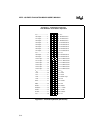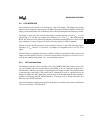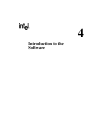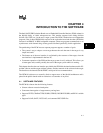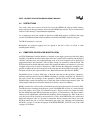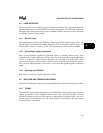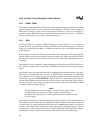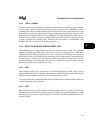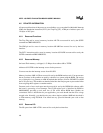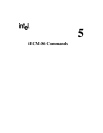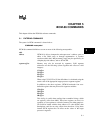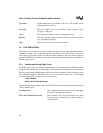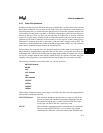
INTEL 186 EB/EC EVALUATION BOARD USER’S MANUAL
4-4
4.5.2 -COM2, -COM1
These options tell the iECM-86 software which serial communication port is to be used. If neither
option is entered, COM1 is used as a default. If iECM-86 detects valid CTS (Clear to Send) and
DSR (Data Set Ready) signals from the appropriate COM port, it signs on and displays a
command prompt. When the target is stopped, the command prompt is an asterisk (*). When the
target is already running, the prompt is a greater-than sign (>).
4.5.3 -DIAG
If CTS and DSR are not present, iECM-86 displays a warning message. You can choose to
proceed or exit. It is possible, but not likely, that iECM-86 will operate properly even after the
warning. It is more likely that there is a problem with the serial port or the cabling that prevents
proper operation.
If the problem is not obvious, such as a disconnected cable or no power to the target hardware,
use the -DIAG invocation option to help isolate the problem. The -DIAG option puts the iECM-
86 system in a special mode that allows many tests to be used to find interfacing problems or
target bugs.
The diagnostic mode is intended to support debugging of boards that use iECM-86 software. It
also provides a simple routine to check the communications interface between the host and the
target.
In the board, a serial port loop-back mode allows debugging the host/board interface. Upon reset,
the board is in the echo mode. Until it receives an ASCII slash (/) or backslash (\), it increments
every character it receives from the host and sends the incremented value back to the host. The
LCD displays the word “DIAGNOSTICS” when the board is in echo mode. If a backslash is
received by the RISM, the board leaves echo mode and starts normal operation. When a slash is
received, the board stops echoing incremented received data and starts responding to RISM
commands with the diagnostic flag set.
NOTE
The target hardware has to be reset before using the -DIAG option. When
executing diagnostic routines from Flash, certain commands such as
breakpoints and stepping will not work because they need to modify the code
to work properly.
When the host software is invoked in the diagnostic mode, it prompts you to enter characters on
the keyboard. These characters are sent to the target, and the response from the target is displayed
on screen. This is a simple confidence check on the serial communication channel. You are told
to enter a slash or backslash to terminate this mode and proceed in either the diagnostic mode or
the normal user’s mode. If the user interface is invoked without the -DIAG option, the software
immediately transmits a reverse-slash, which should put the target in the normal mode.



